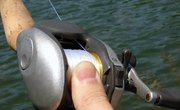A Dipsy Diver is a versatile diving device that helps you troll spoons to a mid-range depth. If you want to fish deeper, use a downrigger. A Dipsy Diver can also be rigged to move your lure left or right. Dipsys are useful tools that no troller should be without.
Background
A Dipsy Diver is a tool that helps your fishing lure--generally a spoon--dive. As line is let out, the Dipsy plows through the water, and the weight-forward design makes it dive. A spoon or other lure is fished behind the Dipsy.
Rod Choices
Use a rod that has enough backbone to pop the Dipsy free of planing mode, but not too stiff to play the fish. Many rod manufacturers make rods just for this purpose.
Line Considerations
Dipsys can be fished on monofilament, braided or wire lines. The instructions pamphlet that comes with your purchase gives achieved depths based on using 20-pound monofilament. However, braided lines and wire lines (which help the Dipsy dive even deeper) may be more effective because they don't stretch. When a fish hits, set the hook to pop the Dipsy out of diving mode. When the mechanism releases, the Dipsy planes, making it easier to play the fish. It is hard to pop the mechanism loose with monofilament line.
When using braided or wire lines, attach a "snubber" behind the Dipsy. This is a piece of rubber tubing that acts as a shock absorber so the hook doesn't rip out of the fish's mouth.
After the snubber, tie a length of line no longer than your rod. Using monofilament will make it harder for fish to see your line. Tie a bead chain swivel to the end of the line to reduce line twist, then attach your lure.
Diving Depth
Now decide how deep to fish. The Dipsy chart will give you guidelines, but keep in mind that the chart is based on using 20-pound monofilament. Dipsys run deeper on braided or wire lines. You won't know exactly how deep you're fishing, but if you use a reel with a line counter, you can replicate the depth after you catch a fish.
Trolling speed also affects diving depth. The listed depths are based on a trolling speed of 2.5 to 3 miles per hour.
Options
Under the Dipsy is a dial. Setting it to 0 will cause the lure to run straight behind the boat. This also achieves the deepest dive. Turning it to the left or right on settings 1, 2 or 3 will make it turn accordingly and dive shallower.
An included O-ring that snaps around the Dipsy also affects diving depth. The Dipsy dives deeper with the O-ring in place and shallower when removed.
Tuning
Before fishing, insert the mechanism arm into the slot. This will pop free when you set the hook, making the Dipsy plane instead of dive. Test the snugness of the arm in the slot. When new, it can be tough to pop loose. You can adjust the tension by turning the screw on the side.
Writer Bio
Joe Shead is a freelance writer specializing in outdoor writing. He has written for numerous national and regional outdoor magazines on various topics from hunting to fishing to his pet subject, shed antler hunting.



